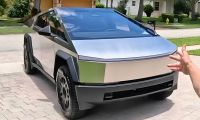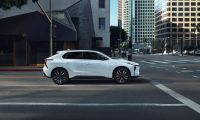BMW chose to market their revolutionary i3 electric vehicle with an optional range extender in the form of a small gasoline engine and fuel tank that effectively extends the vehicle’s range from 82 miles to 150 miles. However, it is a very expensive option that removes some of the green luster from the i3. Has Mercedes found a better solution?
The B-Class Electric Drive is Mercedes’ counterpunch to the BMW i3. Similarly priced at $41,450 before destination charges, the B-Class is more conventional and understated in every way than the i3. It will seat five passengers (as opposed to the i3’s four) and has far less polarizing looks with virtually none of the unorthodox materials prominently featured in the BMW city car.
A cheap path to significantly increased range
Where BMW opted to give consumers the choice of nearly doubling their range with gasoline backup, Mercedes has elected to go a different way. For just $600, buyers can select the “Range Extender” package for their B-Class ED. The minor upgrades: added insulation to improve climate control efficiency and an electrically heated windshield. The major upgrade: unlocking more of the battery’s stored energy.
The Range Extender package includes the addition of a button on the center console that increases the maximum charge level of the battery for the next charge cycle. With this elevated threshold, the vehicle is capable of up to 17 additional miles of range. Up from the 87 miles in standard mode, this range-extended mode enables the B-Class ED to travel up to 104 miles on a charge.
What’s the catch?
The catch is that you can’t use this feature every time you charge. That would actually be a very bad idea. Mercedes representative Terry Wei told AutoblogGreen that the company “can’t really make a suggestion as to how often” is advisable. Mercedes gives a disclaimer with the option, saying “Range extender should only be used on a limited basis, and could shorten battery life if used excessively.” We’ll amend that statement for them: it will definitely shorten battery life if used excessively.
The B-Class battery pack is advertised as 28 kWh, although AutoblogGreen reports that Mercedes confirmed that the actual pack size is 36 kWh. This is not unusual for electric vehicles; using a battery’s maximum available charge can rapidly degrade capacity. It’s why the Chevrolet Volt only has 10 kWh of usable capacity out of 16.5 kWh total, and why conventional hybrids may use only 20-30% of their battery at most to prolong life.
It is obvious that the “temporary range extender” mode simply charges past the default 28 kWh limit imposed on the battery, ignoring concerns about longevity. Charging in this mode every day would wear down the battery in short order, but so long as the feature is used infrequently, the driver likely won’t notice an abnormal impact on capacity loss.
Why every EV maker should take a lesson from Mercedes
As long as the buyer is sufficiently educated on the dangers of abusing a maximum charge mode, it makes a lot of sense for every battery electric vehicle to feature it as an option. Limited range is currently one of the biggest deterrents to pure EV sales, even though most drivers will find that the vast majority of their trips are well within the vehicle’s range capabilities.
Extend that available range by 20% for the occasional longer trip, and suddenly a battery electric vehicle looks much more appealing. How many more LEAF sales would we see if it were capable of traveling 100 miles on a charge when necessary? Tesla acknowledges the value in this feature, as Model S can be charged beyond its default threshold for an extra 15% charge in “range mode.”
If used in moderation, perhaps once a week or less, the maximum charge option has minimal side effects. And for the vast majority of drivers, the feature will rarely be needed anyway but will help alleviate range anxiety in the consideration of purchasing an EV. We will point out the potential for abuse by drivers who are leasing an EV for two or three years; heavy use of the feature could and should hurt the resale value of the car, although it will be difficult to tell just how much the battery will be impacted for the next owner.
Wei said the feature is provided as an option on the B-Class because Mercedes doesn’t think most customers will need the additional range. It will be interesting to see how many buyers opt for the cheap occasional range extension – our money is on quite a few, as there is little reason not to beyond the reasonable $600 price tag. Those 17 miles could make a big difference to prospective buyers.












Comments
This is not a good idea. The
Permalink
This is not a good idea. The way this feature is described unfortunately misinforms the buyer, and does not do much good in terms of educating the public about the properties of lithium-ion batteries and their longevity.
How did a cyber-attack lead
Permalink
How did a cyber-attack lead to long queues for petrol in the US?
WOW
Permalink
WOW
Cathie Wood holds these stocks for triple-digit upside — and they're on sale.
Stable dividend stocks are great for the risk-averse.
But for investors looking to add some pop to their portfolios, nothing beats the long-term upside of rapidly expanding growth stocks.
London Market Open: boohoo
Permalink
London Market Open: boohoo sinks after warning on profit margins
Alliance News - Stock prices in London opened higher on Thursday with the internationally exposed FTSE 100 supported by sterling weakness, while on AIM fashion retailers were lower after boohoo cut its guidance.